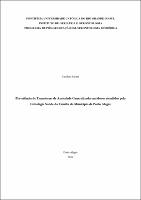| Share record |


|
Please use this identifier to cite or link to this item:
https://tede2.pucrs.br/tede2/handle/tede/2740Full metadata record
| DC Field | Value | Language |
|---|---|---|
| dc.creator | Menta, Caroline | - |
| dc.creator.Lattes | http://buscatextual.cnpq.br/buscatextual/visualizacv.do?id=K4730444E4 | por |
| dc.contributor.advisor1 | Cataldo Neto, Alfredo | - |
| dc.contributor.advisor1Lattes | http://buscatextual.cnpq.br/buscatextual/visualizacv.do?id=K4704404Z8 | por |
| dc.date.accessioned | 2015-04-14T13:54:12Z | - |
| dc.date.available | 2014-08-26 | - |
| dc.date.issued | 2014-03-17 | - |
| dc.identifier.citation | MENTA, Caroline. Prevalência de transtorno de ansiedade generalizada em idosos atendidos pela estratégia saúde da família do município de Porto Alegre. 2014. 54 f. Dissertação (Mestrado em Gerontologia Biomédica) - Pontifícia Universidade Católica do Rio Grande do Sul, Porto Alegre, 2014. | por |
| dc.identifier.uri | http://tede2.pucrs.br/tede2/handle/tede/2740 | - |
| dc.description.resumo | O transtorno de Ansiedade Generalizada (TAG) é uma desordem mental comum, que normalmente tem início precoce, curso crônico e um alto grau de comorbidade com outros transtornos de ansiedade e de humor. Apesar da alta prevalência do TAG em idosos, as características psicopatológicas da preocupação excessiva são pouco conhecidas. Este é um estudo com desenho transversal, que conta com uma amostra de base populacional de 578 indivíduos com 60 anos ou mais, pertencentes à Estratégia Saúde da Família (ESF) de Porto Alegre, Brasil. O objetivo é avaliar a prevalência do TAG nessa amostra e correlacionar com características sóciodemográficas e de saúde. O Mini International Neuropsychiatric Interview Plus (MiniPlus) foi o instrumento diagnóstico utilizado. Em relação aos resultados, a prevalência de TAG em idosos foi de 9% (IC:6.9 -11 .6). A amostra foi caracterizada por ser predominante em: mulheres (63,8%), idosos mais jovens (62,4%), analfabetos ou indivíduos com baixa escolaridade (61,6%) e baixa renda (93,2 %). O TAG foi estatisticamente significativo nas seguintes variáveis: sexo feminino (10,8%, P.04), faixa etária de 60-69 anos (11%, P.047) , não estar aposentada (14,7%, P.001), morar com 4 ou mais pessoas (11,9%, P.019) e ter histórico de quedas (18,8%, P.003). Além disso, internar mais do que uma vez no último ano e apresentar auto-percepção de saúde regular também evidenciaram associação significativa. Este estudo demonstrou associações com características sociodemográficas que não foram previamente examinados na literatura atual e que devem ser mais pesquisadas. Associações com sexo, renda e saúde abrem possibilidades para novos testes de hipóteses em TAG na população idosa em países de baixa renda. | por |
| dc.description.abstract | Generalized Anxiety Disorder (GAD) is a common mental disorder that typically has an early age of onset, a chronic course, and a high degree of comorbidity with other anxiety and mood disorders. Despite the high prevalence of GAD in older adults, little is known about psychopathological features of excessive worry in the elderly. This is a cross-sectional study with a population-based sample of 578 individuals aged 60 years or more from the Family Health Strategy (FHS) of Porto Alegre, Brazil. Diagnosis were made by psychiatrists using the Mini International Neuropsychiatric Interview plus (MINIplus). The objective was evaluated a prevalence of GAD in elderly and to correlate association between GAD and sociodemographic and health characteristics. Total sample was characterized by: predominance of women (63.8%), younger elderly (62.4%), illiteracy or very poor schooling (61.6%), and low income rates (93.2%). The prevalence of GAD was 9% (IC:6.9-11.6). The main uncontrolled findings shows higher frequencies of GAD in female gender (10.8%,P.04), 60-69 age group (11%,P.047), not retired (14.7%,P.001), cohabitation with 4 or more people (11.9%,P.019), and history of falls (18.8%,P.003). Not being retired, history of falls, cohabitation with four or more people, heaving more than one hospitalization per year and poor self-perceived health presented significant association with GAD. This study presents associations with sociodemographic characteristics that weren´t examined previously in current literature and that should be further researched. Associations with gender, income and health open possibilities for new hypothesis tests in GAD or other anxiety disorders in elderly population in low income countries. | eng |
| dc.description.provenance | Made available in DSpace on 2015-04-14T13:54:12Z (GMT). No. of bitstreams: 1 460643.pdf: 15087236 bytes, checksum: 82cc3d15bfdc8ab7ceb74bff3b09b1e3 (MD5) Previous issue date: 2014-03-17 | eng |
| dc.format | application/pdf | por |
| dc.thumbnail.url | http://tede2.pucrs.br:80/tede2/retrieve/11157/460643.pdf.jpg | * |
| dc.language | por | por |
| dc.publisher | Pontifícia Universidade Católica do Rio Grande do Sul | por |
| dc.publisher.department | Instituto de Geriatria e Gerontologia | por |
| dc.publisher.country | BR | por |
| dc.publisher.initials | PUCRS | por |
| dc.publisher.program | Programa de Pós-Graduação em Gerontologia Biomédica | por |
| dc.rights | Acesso Aberto | por |
| dc.subject | GERONTOLOGIA BIOMÉDICA | por |
| dc.subject | TRANSTORNOS DE ANSIEDADE | por |
| dc.subject | ANSIEDADE | por |
| dc.subject | IDOSOS | por |
| dc.subject | ENVELHECIMENTO | por |
| dc.subject.cnpq | CNPQ::CIENCIAS DA SAUDE::MEDICINA | por |
| dc.title | Prevalência de transtorno de ansiedade generalizada em idosos atendidos pela estratégia saúde da família do município de Porto Alegre | por |
| dc.type | Dissertação | por |
| Appears in Collections: | Programa de Pós-Graduação em Gerontologia Biomédica | |
Files in This Item:
| File | Description | Size | Format | |
|---|---|---|---|---|
| 460643.pdf | Texto Parcial | 14.73 MB | Adobe PDF |  Download/Open Preview |
Items in DSpace are protected by copyright, with all rights reserved, unless otherwise indicated.




